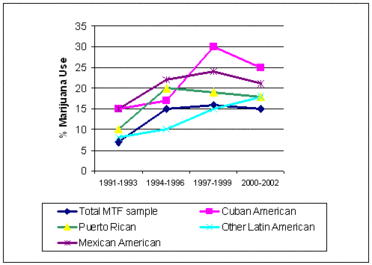STASH Vol. 2(6) – Marijuana use among Latino youth in the US
Although drug use among American youth has decreased during recent years, studies show that drug use among Latino adolescents remains disturbingly high (Johnston, O’Malley, & Bachman, 2002, 2003). This trend is particularly concerning given demographic patterns among the general population. According to the US Census, Latinos will represent a quarter of the total population by the year 2050 (U.S. Census Bureau). Given that Latinos are the largest racial and ethnic minority in the United States, it is imperative to expand research about drug use in this population (U. S. Census Bureau). This week’s STASH discusses the University of Michigan’s Monitoring the Future Study data about marijuana use among Latino 8th grade students in the United States (Delva et al., 2005).
Delva et al. examined questionnaire responses from a sample of 24,235 8th grade students participating in the Monitoring the Future Study from 1991-2002 who self-identified as Hispanic (i.e., Mexican American, Puerto Rican, Cuban American, or other Latin American ethnicity). The Monitoring the Future Study utilizes a multistage sampling procedure to obtain a nationally representative sample of secondary school students across the US. Yearly sampling procedures for the study include selection by (1) US geographic regions, (2) approximately 420 schools, and (3) approximately 42,000 students within schools. The response rate was approximately 90% for 8th grade students.
Participating students completed self-administered questionnaires during regular class periods. The questionnaire included measures of past-year marijuana use and sociodemographic characteristics (e.g., gender, ethnic group, first language). To examine drug use trends, the authors aggregated data by 3-year intervals: 1991-1993, 1994-1996, 1997-1999, and 2000-2002. The authors reported marijuana use trends for Hispanics grouped by ethnicity and for all 8th grade students who participated in the Monitoring the Future (MTF) study.
Figure. Past-year Marijuana Use Among Hispanic 8th Grade Students. Click image to enlarge.
The majority of Latino students were of Mexican descent (67%; N = 16,280). The remaining students were of Puerto Rican (14%; N = 3,403), Cuban (4%; N = 997), and other Latin American (14%; 3,555) descent. A greater percentage of students reporting that their families were from Cuba and Latin America said that Spanish was their first language than did Mexican American or Puerto Rican students. As Figure 1 shows, marijuana use increased from the early to the late1990s for all but other Latin Americans followed by a small decline during 2000-2002. The trends among Latinos were generally consistent with the trends in the general population of 8th graders but varied by ethnicity. Although trends for Cuban Americans appeared more marked than the other groups, this variation might be due to the smaller sample size for Cuban Americans.
This study has some limitations. First, this study is based on self-report; it is possible that assessment is bias (i.e., some students did not report drug use accurately). For example, students might under report marijuana use since such use is illegal and they fear being arrested. Second, the authors were unable to use some additional measures of acculturation and psychosocial factors (e.g., stress, depression); including these measures might have provided more insight about the relationship between ethnic identity and substance use as well as differences in use among the Latino population in the United States (De La Rosa, 2002). For example, one group might acculturate differently from another regarding how they handle the stress associated with balancing cultures, perceived racism, and identification.
Despite its limitations, this study provides important information about marijuana use among the Latino population in the United States. It is interesting to note the heterogeneity of drug use patterns within the Latino community. The study illustrates the necessity to examine heterogeneity within ethnic groups and interactions between ethnic populations and drug use. Further research can elucidate risk factors for marijuana use and develop effective prevention and treatment programs specific to the needs of high-risk populations.
What do you think? Please use the comment link below to provide feedback on this article.
References
De La Rosa, M. (2002). Acculturation and Latino adolescents’ substance use: A research agenda for the future. Substance Use & Misuse, 37(4), 429–456.
Delva, J., Wallace, J. M., O’Malley, P. M., Bachman, J., Johnston, L. D., & Schulenberg, J. E. (2005). The Epidemiology of Alcohol, Marijuana, and Cocaine Use Among Mexican American, Puerto Rican, Cuban American, and Other Latin American Eighth-Grade Students in United States: 1991-2002. American Journal of Public Health, 95(4), 696-702.
Johnston, L. D., O’Malley, P. M., & Bachman, J. G. (2002). Demographic Subgroups Trends for Various Licit and Illicit Drugs, 1975-2001. Retrieved December 31, 2004, from http://monitoringthefuture.org/pubs/occpapers/occ57.pdf
Johnston, L. D., O’Malley, P. M., & Bachman, J. G. (2003). Monitoring the Future National Survey Results on Drug Use, 1975-2002 (No. 03-5375). Bethesda, Maryland: National Institute of Drug Abuse.
U.S. Census Bureau. Projections of the total resident population by 5-year age groups, race and Hispanic origin with special age categories, 2001-2005. Retrieved July 5, 2006, from www.census.gov/population/projections/nation/ summary/np-t4-b.pdf
U.S. Census Bureau. USA Statistics in Brief. Retrieved July 5, 2006, from www.census.gov/statab/www/poprace.html
